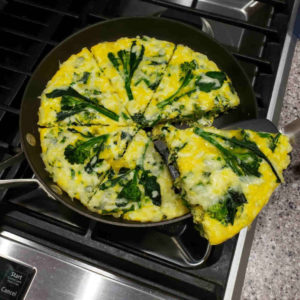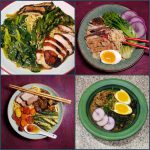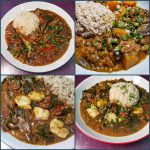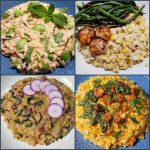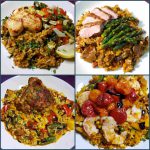Frittata Mother Dish Technique
Frittatas are delicious egg casseroles that are equally appropriate for the breakfast table and the dinner table. The fact that they are quite flexible from the ingredients perspective makes me classify them as a mother dish. Learn to make a basic frittata, and you can make fresh, seasonal ingredients the star of the dish any time of year.
Introduction
Frittatas have a reputation as a breakfast dish, but if you pair the frittata with a good crusty bread and a tasty salad, you have a really nice dinner combination. Frittatas also have a reputation for being a great way to use up whatever leftover bits that you have in the refrigerator. That speaks to the flexibility of a frittata, but I think it downplays how fine a dish a frittata can be. Frittatas really shine when you make fresh, seasonal produce the star. So many things can work well. As long as the flavors you choose work with eggs and cheese, you are set.
The Basic Technique
Whatever ingredients you select, they should be cooked before the eggs are added. Generally, you will start by preheating the oven. Next you cook up the ingredients in an oven-proof, non-stick skillet. Then you whisk up some eggs and optional cream and pour them over the ingredients in the nonstick pan. Give things a quick stir, top with cheese and throw the skillet into the oven. When the eggs are set, the frittata is done. Pull it out of the oven, slice it into wedges, and enjoy.
Flavor Profiles
The egg base of a frittata provides a blank canvas to work with. Generally, you pick a star ingredient or two to define the frittata, and then pick a cheese to provide either contrasting or complementing flavors. For example, if you choose mushrooms and arugula as the co-stars of the frittata, you can use a cheese like Gruyère to complement the stars’ earthy flavors. On the other hand, you could use a tangy chèvre to contrast their flavors. Both are excellent choices.
I usually provide a savory backbone to the dish by starting with a sauté of diced onions and garlic. Once the onions have softened and are translucent, I mix in the stars of the dish for cooking. This works well for any greens including kale, spinach, or Swiss chard (my favorite green for frittatas). For greens with hearty stems, I will remove the stems and finely dice them up and cook them alongside the onions, so they have plenty of time to tender up. Starting with a sauté of diced onions and garlic also works nicely with broccoli, asparagus, melted summer squash and roasted eggplant.
Nuances
When I make a frittata, I am going for a custardy texture. The texture of an overcooked frittata is rubbery. A rubbery frittata may still taste good, but nothing beats the creamy mouthfeel of custardy eggs. Adding some full-fat dairy to the whisked eggs is one way to help ensure that custardy texture. I tend to use an ounce of heavy cream for eight large chicken eggs. The purpose of that dairy is the milk fat. If you use whole milk instead of cream, then I’d suggest two ounces, one and a half ounces for half and half.
The choice of eggs can also make a difference. I buy duck eggs from Open Door Farm at the Carrboro Farmers’ Market. The obvious difference between duck eggs and chicken eggs is size, with duck eggs being larger. I usually make frittatas in a 10-inch, non-stick skillet, either with 8 chicken eggs or 6 duck eggs. But the real difference between duck eggs isn’t size, it’s the yolk to white ratio. The ratio of yolk is much higher in duck eggs, which leads to a luxurious frittata.
The oven temperature under which you finish the frittata also has nuances on the finished dish. If you survey frittata recipes on the internet, you’ll find temperature recommendations ranging from as low as 325°F all the way up to 425°F. More often than not, the recommended temperatures are at the high end of the range. For me, however, I stick with the low temperature of 325°F. This is totally preference, and I welcome you to make frittatas the way you like frittatas. The different temperatures result in different levels of browning. I’m not a fan of browned eggs. Hence, I use the gentler temperature of 325°F. If you like eggs that are browned on the edges, by all means, raise the oven temperature.
The ingredients incorporated into the frittata should be chopped pretty finely to make slicing the frittata easier. I like to serve directly from the non-stick skillet, so the frittata needs to be sliceable using a spatula that is safe for non-stick surfaces. If you really want to have chunky contents inside the frittata, you may have to transfer the frittata to a cutting board so you can slice it with a sharp knife. One exception to that rule is when you can arrange whole pieces on the top of the frittata for the appetizing visual result. Arrange the whole pieces in a manner that accentuates the slices.
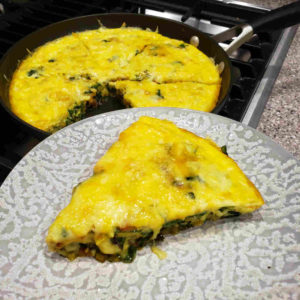
Frittata Mother Dish Technique
Equipment
- 10” oven-safe non-stick skillet
Ingredients
- 12-16 oz fresh, seasonal vegetables
- 1 medium yellow onion (6-8 oz) diced
- 1-2 cloves garlic minced
- olive oil
- 8 large eggs see note
- 2 oz cream see note
- 4 oz cheese grated
- salt and pepper to taste
Instructions
- Preheat the oven to 325°F.
- If the vegetables are or include greens, remove the stems from the leaves and finely dice the stems to be cooked with the onions.Sauté the onion in olive oil with about ½ tsp of salt on medium high heat. Use enough oil to make everything glisten, but not have a pool of olive oil underneath. About 1 tablespoon should work. Sauté, stirring frequently, until softened. Expect about 5 minutes.
- Add the garlic to the pan, and sauté for another minute or two.
- Add the seasonal vegetables to the pan and sauté until properly cooked.
- While the vegetable sautés, beat the eggs with the cream, ½ tsp of salt and a few cranks of the pepper grinder.
- Evenly distribute the vegetables in the pan and pour the egg mixture over. Give a quick stir to suspend some of the vegetables off the bottom of the pan. Sprinkle the cheese evenly over the top (don’t skimp at the outer edge!).
- Transfer the pan to the pre-heated oven and cook until done. Timing will vary for various reasons. Other than the true oven temperature, the biggest variable is the amount of seasonal vegetables that are in the pan. As they have just completed cooking, they hold a lot of heat. The more of them, the quicker the cook. Start checking for doneness after about 10 minutes. There should be no jiggle if you shake the pan. A toothpick test can reveal if there is any runny egg. You are going for a custardy egg. Too little time is runny and too much time is rubbery.
Notes
- If you have access to duck eggs, use 6 duck eggs instead of 8 large chicken eggs. The larger yolk to white ratio that duck eggs have makes an indulgent frittata.
- The cream is to add milk-fat to enhance the creaminess of the final dish. You can use half-and-half, or whole milk if you don't have cream. If you only have 2% or skim milk, just skip the dairy. The frittata will still be good, but it won't be as custardy as it could be.

